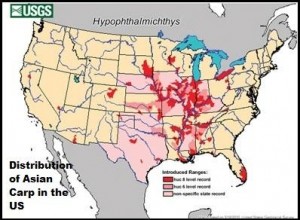Multiple species, including the black carp, Mylopharyngodon piceus; grass carp, Ctenopharyngodon idella; silver carp, Hypophthalmichthys molitrix; and large-scale silver carp, Hypophthalmichthys harmandi.
Native Range: Asia. The black carp is found in China and parts of Russia and Vietnam.
Invasive Range: Throughout the Mississippi River watershed
Habitat: Large warm-water rivers and impoundments.
They can swim up the Mississippi River. They can fly over a fishing boat, ten feet in the air, hitting fishermen with the force of a bowling ball. They won’t take bait from hook, and they’re bony—so what’s to like about Asian carp? They’re invaders that taste good.

Courtesy asiancarp.org
Asian carp—the silver and the bighead—introduced in the 1970s to Southern catfish farms and municipal sewage ponds to eat the overgrowth of algae, escaped. Steadily, the fish have made their way north, eating as they went, consuming up to 40% of their body weight at day. Filter-feeding on zooplankton, phytoplankton, detritus, and algae, they have quickly became the most abundant species in some areas of the Mississippi, easily out-competing the natives and changing habitat for the worse. They eat continuously. They reproduce prodigiously. They inhabit a third of the rivers in the Mississippi and Ohio drainage as far north as the Chicago Ship and Sanitary Canal, which connects the Mississippi to the Great Lakes, and have been sighted nearing Lake Michigan. Can the Great Lakes, at least, be saved from them? Can we human predators help buy time until a way to eradicate or at least control their numbers elsewhere can be found?
It’s true that a seriously bony fish is going to have a low meat yield of only 20% to 25%. But the Asian carp is a filter feeder, so it doesn’t have the muddy taste associated with the bottom-feeding common carp. Since the Asian carp feeds at plankton-level on the food chain, it’s low in contaminants like mercury and PCBs. And it’s low in fat, and some say it tastes just like cod.
“The Asian carp filets are as good as anything you can find in the water,” Duane Chapman, research biologist at the Invasive Carp Research Program, US Geological Service, said of home cooking. “We usually put some rub on it and stick it on the grill and eat it that way. Sometimes we make ceviche, or we’ll fry it up for company. You can make fajitas with the carp or smoke it; add it to curry or soup; or just steam it. It’s delicious.”
To read more about these invaders, check out the Detroit Free Press’s definitive six-part series, The Truth About Asian Carp.
Also read Ian Frazer’s excellent article in The New Yorker: “Fish Out of Water.”
Adventures with Jumping Carp. (They should have kept them!)
Preparing Asian Carp
Unlike its common cousin, Cyprinus carpio, Asian carp is not a muddy-tasting bottom-feeder; it’s a filter-feeder that loves plankton. But it is bony, so it’s best turned into fillets. Duane Chapman, USGS fish biologist known as The Carp Guy, shows you his chef-level knife-skills on YouTube.
Fajitas Carpitas
Adapted from Duane Chapman
Serves 5
2 pounds deboned Asian carp pieces
10 soft tortillas, fajita size
Ingredients for the marinade
1/4 cup lime juice
1/2 cup water
2 tablespoons olive oil
4 cloves garlic, crushed
1 teaspoon salt
1/2 teaspoon cayenne pepper
1/2 teaspoon ground black pepper
Fajita toppings
salsa, pico de gallo, cheese, guacamole, or shredded lettuce
1. Mix ingredients for fajita marinade in a large resealable bag.
2. Marinate carp pieces in fridge for at least 1 hr.
2. Grill fillets with a fish basket or aluminum mesh. (If you’re careful, this is not necessary, as carp is quite firm.)
3. Place grilled fish in covered bowl and deliver to table.
4. Let diners construct their own Fajitas Carpitas from the toppings.




























{ 3 comments… read them below or add one }
Looking at the video of how these Asian Carp jump out of the water, when they panic at the sound of a motorized boat, suggests to me an easy way to catch these fish for commercial harvesting; outfit a motor boat with optimally designed hoop nets or buckets, and just let the fish leap into these. If the motorized boat is solar powered, the business operators would have low overheads, since the boats wouldn’t need to travel very fast, they may catch sufficient fish to make the venture profitable.
This may turn these fish from a pest into a valuable food commodity. And they may be canned if they taste just as good or better than canned tuna, to reduce the pressure on wild tuna populations, by offering consumers a lower cost alternative.
There used to be a time when America used to use Blue Fin Tuna has fertilizer and animal feed because they lacked the pristine white colors needed to be sold as canned tuna. Only after Japanese airliners tested out a new container good enough to hold frozen fish did Blue Fin Tuna become a valued fish for American fisherman. There’s a moral to this history. Asian Carp might be a pest and useless fish in America, but always look to sushi. There’s always a market for new fish species in the raw fish sector!
Harvest them commercially and turn them into fertilizer or animal feed.
{ 4 trackbacks }